Tag Archives: american
Three Different Engrain And Side Grain Cutting Board With Inlays American Flag Honeycomb Turtle
Large Porcelain Vase Enameled Etched Floral Motif Hand Painted American Satsuma
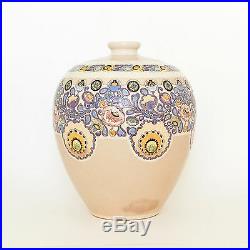
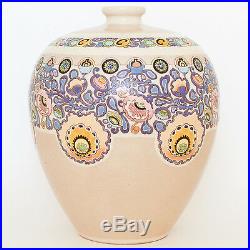
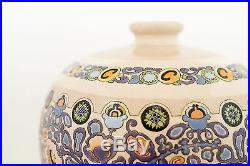



Two Tone Beige, Large Round American Satsuma Vase, Raised Multi-colored Enameled Floral Design Very nicely crackled surface. Vase measures 10″ Tall with a small spout, mouth opening about 2-3/4″, width is about 8-1/2. Hand decorated by an American China Painter on blank Satsuma. The vase is dark and light cream based (two toned) Has black outlined enamel detailed borders, and symmetrical conventional flower designs circling the piece in a variety of colors from yellow, lavender, pink, lime green, orange, dark blues, pinks. American Satsuma Description: I offer you a bit of insight acquired in my study research and devoted experience to this art movement. The history of pottery, china and porcelain is fascinating in America. It is one of the oldest, the longest, and most widely diffused of all human arts not very common in American houses until the middle of the 18th century. A fine example of this history is “Satsuma” or “Satsuma ware” a Japanese pottery of distinctive creamy beige to dark cream color, which was considered by American china painters or decorators in the early 1900’s very suitable only for metal (such as gold) and enamel decoration. This earthenware was available in different shapes and is in fact an export product specifically designed in the early to mid 19th century to cater to the western export market at the time, later called “American Satsuma”. This is not to be confused with the 17th century or older Japanese Satsuma. These plain Satsuma (or blanks) was the choice for artists to hand paint and decorate. All pieces were imperfect; the glaze being badly “crazed” (cracked in fine little lines) all over the surface, this defect has come to be widely accepted as a distinguishing quality and charm of this ware. Another interesting fact that its body does not “ring” when tapped like other china. Often elaborately painted, American Satsuma pieces have a wonderful sense of artistic design and theory behind it exhibiting for example Conventional Art Deco and Art Nouveau styles, floral designs, motifs from nature (most commonly landscapes, small animals, birds, bugs, butterflies, trees, leaves), symmetrical elements, decorative monograms, along with a wonderful sense of color schemes and tonal balance. The adaptation of design to architectural and structural shapes of the porcelain was also considered when decorating as an expression of idea. From amateurs to serious artists, this craft developed quite a following. For those of you interested in the subject. I encourage to continue your exploration to learn more about the subject. Please review our policy. If you have any questions, don’t hesitate to send me a message. The item “Large Porcelain Vase Enameled Etched Floral Motif Hand Painted American Satsuma” is in sale since Thursday, August 7, 2014. This item is in the category “Antiques\Decorative Arts\Ceramics & Porcelain\Vases”. The seller is “porcelainbooksjewelry” and is located in Santa Fe, New Mexico. This item can be shipped worldwide.
- Age: 1900-1940
- Original/Reproduction: Original
- Color: Beige
- Country/Region of Origin: United States
- Primary Material: Ceramic & Porcelain
- Style: Art Nouveau

En0758jjFk American Hand Painting Clifton Karhu DRAGON
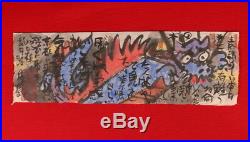

Before purchasing our item, please read and understand our business policy and business approach below. We collect and sell valuable items which we confidently recommend at fair prices. One exception to it would be when customers take items without written statements of guarantee to publically qualified appraisal authorities and when they are clarified as forgeries by them (not based on customers’ own opinions or by third parties they choose). Thank you very much for your kind understanding. USA Hand Painting(makuri). Dragon A letter written by Mr Clifton Karhu to Mr. Contents of this letter. Thank you very much for sending a lovely book for me, but next time the new book must be more exciting! I always admire that the book I showed at that Tambaya was truly amazing, Let’s do your best next year! If you come to Kyoto, please come and visit me. A new Year of Dragon. (1927 – 2007) was born in Duluth, Minnesota in 1927. From 1946 to 1948, he lived on an American navy base, in Sasebo, Japan. From 1950 to 1952, Clifton studied at the Minneapolis Art School honing his interests in art. While on this great venture as a missionary, he decided to become an artist by producing watercolors, oil paintings, and Sumi-e works. He would exhibit at local galleries and by doing so, gained an important reputation within the community. In 1961, he won first prize at the Chubu Taiheijo Bijutsu Kyokai Ten (The Middle Pacific Art Group Exhibition). He presented his first exhibition in Gifu prefecture where he resided for some time. Karhu moved to Kyoto, and became highly interested in the woodblock print process. In Kyoto, he would have one of his most successful woodblock print exhibitions, which garnered his name as one of the top artists in Japan. Since then, Clifton has exhibited his prints widely throughout the world, and today has become one of the most successful contemporary woodblock print artists. His prints often depict typical old Japanese houses, temples, rooftops, shops, and old town settings of Kyoto using bold lines, patterns, and strong colors. Material = Paper Condition= Normal (A little folding line). Size = 19.5 x 59.5 cm. Weight = 10 g (packing material is not included). Please do not hesitate to ask us for the best price and any other questions. It arrives in 5-7 days. Please let us know your TELEPHONE NUMBER that we write on the postal document and invoice. Please understand that the item has stains and wrinkles, but it is vintage. Since it is an old item, please look at the pictures closely and judge. The actual size, color or appearance may vary because of the lighting effects. Chosen carefully, we would guarantee these are handwriting (not printed) and the original. The item “En0758jjFk American Hand Painting Clifton Karhu DRAGON” is in sale since Tuesday, October 16, 2018. This item is in the category “Antiques\Asian Antiques\Japan\Prints”. The seller is “en-corporation” and is located in HONSHU. This item can be shipped worldwide.

Original antique 1923 JAPANESE AMERICAN YAMADA BASKE PAINTING MT FUJI
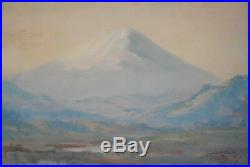
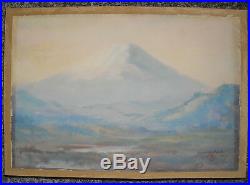


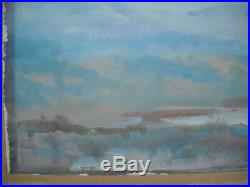

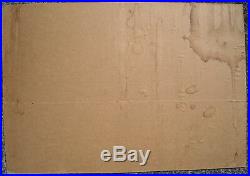
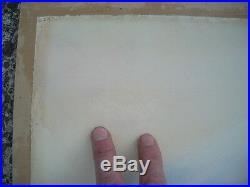
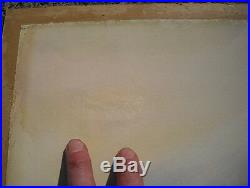

This painting is watercolor on paper laid down on paperboard. It is signed by the artist lower right: Yamada Baske 23. Below the signature is a round red painted seal. The paper measures 14″ by 20 1/2″. The paperboard to which the painting is affixed measures 15 1/4″ by 21 7/8″. I believe the painting depicts Mt Fuji. The painting is in good condition. As you can see from the photo of the back, it got wet at some point in it’s history and that water bled through to the front in a small area of which you see two photos with my two fingers below the water stain. That small stained area is raised slightly from the backing and appears to have been rubbed as the paper there is a little shiny compared with the matte appearance of the overall painting. There is darkening around the perimeter probably from the former framing and matting. Other than the one area it appears to be in very good condition. A superlative work by this respected Japanese American artist who traveled back and forth between the two countries often. Questions always welcome and thanks for looking. Below is a partial biography from Askart: The painter now best known as Yamada Baske was born “Fukawa Jin Basuke” in Tokyo in 1869 and first studied art at the Furoko School, Tokyo. After coming to America in 1885 he continued his studies at the Art Students’ League in New York; at the Pennsylvania Academy of the Fine Arts; and from 1897 to 1899 at the Philadelphia School of Industrial Art (the March 1907 Philadelphia Museum bulletin described him as having been a “brilliant student”). Among his teachers were William Merritt Chase; Herman F. Later he organized the “Basuke Sketching Class” of Yokohama, and also taught for a time at the Tokyo Fine Art School (now known as Tokyo Geijutsu Daigaku) where his exhibited work won prizes and honorable mentions. Basuke exhibited at the Beard Art Galleries in Minneapolis, Minnesota, attracting the attention of the Minneapolis School of Fine Arts, for whom he began teaching watercolor classes in 1907. His hallmark misty landscapes became (and remain) his most popular subjects. Baske died in 1934. In 2000 a major exhibition of his work was held at the Morikami Museum, Delray Beach, Florida. He is listed in Who Was Who in American Art, and first appeared in Who’s Who in American Art in 1915. Sources: Minneapolis Society of Fine Arts Bulletin, Jan. 1907; The Philadelphia Museum bulletin, Volumes 1-5 JanuaryMarch. 1907; AskArt. Com; iOffer. Com; various internet pages accessed September 5, 2010. The item “Original antique 1923 JAPANESE AMERICAN YAMADA BASKE PAINTING MT FUJI” is in sale since Monday, August 28, 2017. This item is in the category “Art\Paintings”. The seller is “mkvanvig1″ and is located in Portland, Oregon. This item can be shipped worldwide.
